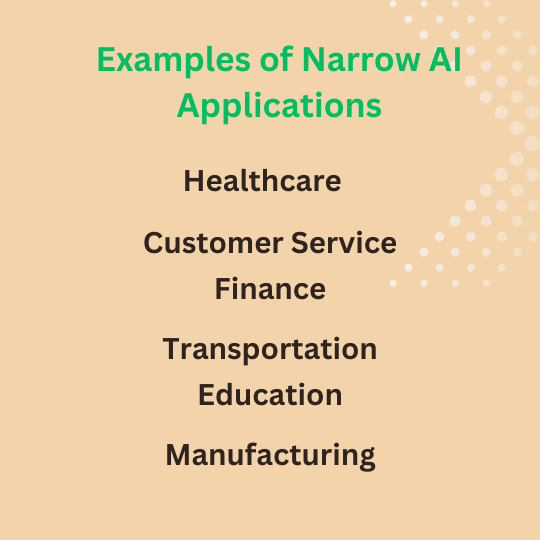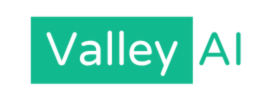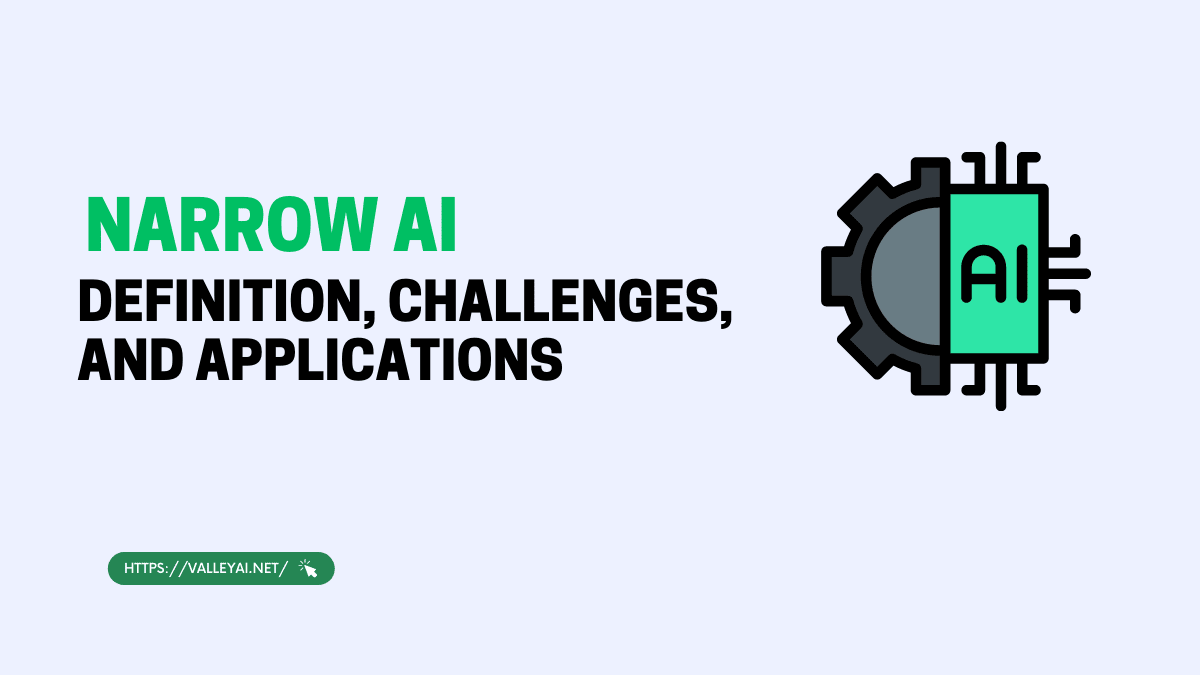In this post, we will explore what is narrow AI, the definition and characteristics of narrow AI, as well as examine various examples of its applications in real-world scenarios. From voice assistants to image recognition systems, narrow artificial intelligence has demonstrated its effectiveness in performing focused tasks, revolutionizing industries, and enhancing our daily lives with this type of AI.
Understanding the different types of AI, including narrow AI, is crucial in grasping the full potential and impact of this rapidly advancing technology.
Key takeaways:
- Narrow AI refers to artificial intelligence systems that are designed for specific tasks or applications, rather than having a general intelligence like humans.
- Examples of narrow AI applications include virtual personal assistants, recommendation systems, and autonomous vehicles.
- Advantages of narrow AI include increased efficiency, improved accuracy, and the ability to automate repetitive or complex tasks.
- Challenges faced by narrow AI include bias in algorithms, ethical considerations, and the need for ongoing training and maintenance.
- Best practices for narrow AI development include robust data collection, rigorous testing and validation, and collaboration between AI developers and domain experts.
- Narrow AI has the potential to revolutionize various industries, improve productivity, and enhance decision-making processes.
Definition and Characteristics of Narrow AI
Narrow AI, also known as weak AI, refers to AI systems that are designed for specific tasks or narrow domains. Unlike general AI, which tries to act like humans and learn any task, narrow AI only does a few jobs and can’t learn new tasks.
Features of narrow AI are: it is made for one area, it has only a bit of knowledge, and it relies on lots of data for learning and making decisions. It is programmed with algorithms that help it do tasks quickly and correctly.
In healthcare, finance, and marketing, narrow AI is used. In healthcare, it helps doctors diagnose diseases and guess patient outcomes. In finance, it is used to detect fraud and assess risk. In marketing, it looks at customer behavior and customizes ads.
Narrow AI has many advantages like accuracy and productivity, but it has challenges too. It needs a lot of data for training, the algorithms can have biases from the data, it doesn’t adapt to new tasks or environments, and there are ethical concerns around privacy and responsibility.
To make sure narrow AI works well, it must be tested and validated for accuracy and reliability. It must be monitored and updated, documented to be understood, and follow ethical guidelines.
Examples of Narrow AI Applications
Technology is quickly advancing and there are plenty of uses for Narrow AI. These systems are designed to do one task well, in a certain range, but they don’t have the same brainpower as humans. We can split up Narrow AI applications into different domains. Here are some:

- Healthcare: Automated diagnoses, virtual nursing help, medical image analysis tools.
- Customer Service: Chatbots for help, voice recognition for phone calls.
- Finance: Fraud detection algorithms, automated investment help.
- Transportation: Self-driving cars, traffic prediction models.
- Education: Intelligent tutoring systems, and personalized learning platforms.
- Manufacturing: Robotic process automation, quality control systems.
Narrow AI can be used in many industries. But each domain has different needs and limits when it comes to Narrow AI. For instance, healthcare applications must think about patient privacy rules and ethical issues.
Remember: It’s essential to understand the target domain’s particulars before developing Narrow AI applications. This ensures the application is successful and follows industry rules.
Advantages of Narrow AI
Narrow artificial intelligence, also known as weak AI, has many benefits. It can offer precise and accurate results, allowing businesses to make informed decisions. Plus, it can analyze huge amounts of data quickly. This helps to identify patterns that may be hidden from humans.
This lets companies streamline processes and increase efficiency. Narrow AI can also automate repetitive tasks. This frees up human resources so they can focus on more complex and creative activities.
Narrow AI can also improve customer experiences. It uses advanced algorithms to personalize interactions. It tailors recommendations and suggestions to individual users.
This not only makes customers happy but also provides businesses with valuable insights into customer preferences and behavior. Also, narrow AI can be integrated with existing systems. This lets businesses offer seamless customer service and support.
In healthcare, narrow AI is very effective. It can assist in diagnosing diseases and recommending treatments. This increases the accuracy and speed of diagnosis. In addition, it can analyze patient data to predict potential health risks. This lets healthcare professionals provide proactive interventions and preventive measures.
Summing up, narrow AI offers many advantages. From improving decision-making processes and enhancing customer experiences to revolutionizing the healthcare industry, narrow AI can help businesses and industries reach higher levels of efficiency, accuracy, and innovation.
Challenges Faced by Narrow AI
Narrow AI, or weak AI, has some struggles holding it back from being widely used and successful. One of those is its limited scope. It can do great at certain tasks but can’t adjust to new situations, making it difficult to handle personal problems or deal with traumatic experiences. This limitation makes it hard for narrow AI to tackle complex or unfamiliar problems that need a better understanding of the context, resulting in vague responses.
Data quality and availability are also issues. Narrow AI needs labeled data to learn and make accurate predictions, but it is difficult to get diverse data that is representative. Plus, biases in the training data can cause biased results, which is unfair and can keep certain groups from taking advantage of these AI systems. Additionally, AI must be able to transfer its learning from one neural network to other networks by leveraging prior knowledge, but this is a challenge that must be addressed for AI to evolve further.
Explaining and understanding the decisions of narrow AI is also challenging, especially for those like Elon Musk who have concerns about the potential dangers of AI. They act like black boxes, so users or developers can’t see why the AI is making the predictions or suggestions it is. This lack of transparency raises ethical worries and affects people trust and acceptance of narrow AI for important areas like healthcare or finance.
To handle these issues, developers and researchers must look at ways to enhance adaptability, better data quality and fairness, and create interpretability techniques. Interdisciplinary collaborations and ethical thinking are also important for overcoming these obstacles and realizing the potential of narrow AI.
Pro Tip: When using narrow AI, it is vital to assess the fairness and bias in the training data and regularly monitor the performance to ensure balanced and fair results.
Best Practices for Narrow AI Development
Creating Narrow AI involves specific guidelines. These include:
- Ethical considerations – AI systems must respect privacy, avoid bias, and minimize harm.
- Rigorous testing – Various scenarios and datasets should be used to evaluate performance.
- Transparency and interpretability – Developers must create models that explain their decision-making process.
- Data quality and management – Training data must be cleaned, labeled, and augmented.
- Collaboration and knowledge sharing – Developers should share knowledge and collaborate with experts.
- Continuous improvement – AI systems should be regularly updated and improved.
Narrow AI has a special focus on interpretability and transparency. Unlike general AI, which attempts to mimic humans, Narrow AI is designed for specific tasks. Explaining and interpreting these AI systems is critical to gaining user trust and ensuring ethical use.
Developers must create models that offer clear explanations and insights into how they work. This transparency helps users understand the AI system’s limitations and potential biases.
Conclusion and Future of Narrow AI
Narrow AI, also known as weak AI, applies to AI systems designed to carry out specific tasks. These systems focus on solving one problem or performing a specific function, replicating and potentially surpassing human intelligence. The future of narrow AI has great potential for advancements in various fields, such as transportation and healthcare. As technology advances, narrow AI systems will become more intelligent and capable of handling complex tasks, but it is important to continue researching and developing artificial general intelligence for even greater potential in the future.
At present, narrow AI is already employed in various industries, including healthcare, finance, and transportation. But there is still much room for growth and improvement in harnessing the power of AI. AI systems are projected to be able to process and analyze large amounts of data, make decisions based on complex algorithms, and even learn through machine learning.
One field that offers exciting prospects for narrow AI is autonomous vehicles. As progress continues to be made, self-driving cars are anticipated to become more common on our roads. These vehicles will rely heavily on narrow AI systems, to navigate and make quick decisions to guarantee passenger safety.
Healthcare is another area of potential growth for narrow AI. With increased access to medical data and AI technologies, narrow AI systems can assist healthcare professionals in making more accurate diagnoses, developing personalized treatment plans, and improving patient outcomes. For instance, narrow AI can analyze medical images and spot early signs of diseases, allowing timely interventions and potentially saving lives.
Overall, the future of narrow AI has great potential for advancements in various sectors like transportation and healthcare. As technology progresses, narrow AI systems are expected to become more sophisticated and able to handle complex tasks, ultimately improving our personal lives. Continuous research and development in the field of data science will open up countless possibilities for narrow AI, potentially revolutionizing industries and improving the lives of people around the world.
However, narrow artificial intelligence cannot provide a comprehensive understanding or analysis of complex human behavior or emotions. It is limited to its specific domain and cannot generalize beyond its programmed tasks. Despite this, the use of narrow AI is growing, as technology advances and its benefits become more apparent.
Some Facts About Narrow AI:
- ✅ Narrow AI is designed to handle specific tasks or a limited range of tasks. (Source: Team Research)
- ✅ It is the opposite of strong AI, which can handle a wide range of tasks and emulates sentience or consciousness. (Source: Team Research)
- ✅ Narrow AI is increasingly integrated into various applications in modern society, like spam email filtering, music recommendation services, and autonomous vehicles. (Source: Team Research)
- ✅ Using Narrow AI in critical infrastructure functions, such as the power grid or financial trading, may carry higher risks compared to alternatives. (Source: Team Research)
- ✅ Neural networks used for controlling important systems may be considered less risk averse and more brittle. (Source: Team Research)
FAQs about Narrow Ai
What is narrow AI and how does it relate to modern society?
Narrow AI refers to artificial intelligence systems that are designed to handle a specific task or a limited range of tasks. It has increasingly been integrated into various applications in modern society, such as spam email filtering, music recommendation services, and autonomous vehicles.
How does narrow AI differ from general artificial intelligence?
Narrow AI is focused on performing a single task without human assistance, while general artificial intelligence aims to mimic complex thought processes and can handle a wide range of tasks. Narrow AI is limited to a specific task, whereas general AI is more versatile.
What are some popular applications of narrow AI?
Narrow AI has various commercial applications, including recommendation engines. It is also used in virtual assistants like Siri and Google Assistant, which track weather updates, play games, and provide helpful information.
What are the advantages of narrow AI?
Narrow AI offers faster decision-making, relieves humans from mundane tasks, serves as a building block for more intelligent AI, and can perform single tasks better than humans. It improves overall productivity and quality of life in various industries.
What are the challenges faced by narrow AI?
Narrow AI faces challenges such as the absence of explainable AI, the need for impenetrable security, learning from limited data, potential biases in AI systems, and reliance on fallible humans for data generation and labeling.
How does narrow AI differ from strong AI?
Narrow AI is a subset of tasks that are designed to be goal-oriented, while strong AI has the capacity to handle a wide range of tasks and can potentially emulate sentience or consciousness. Strong AI aims to achieve genuine intelligence, whereas narrow AI is task-specific.
- Understanding the Landscape of Cloud Vulnerability Management - March 25, 2024
- Quality Assurance Strategies for Startups: Ensuring Software Reliability - March 5, 2024
- Working of NLP to Improve Copywriting in AI Paraphrasing Tool - February 28, 2024

